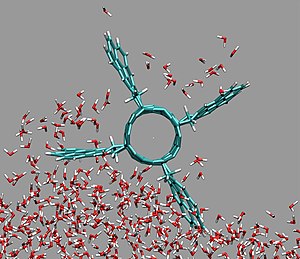
Molecular propeller is a molecule that can propel fluids when rotated, due to its special shape that is designed in analogy to macroscopic propellers:[1][2] it has several molecular-scale blades attached at a certain pitch angle around the circumference of a shaft, aligned along the rotational axis.
The molecular propellers designed in the group of Prof. Petr Král from the University of Illinois at Chicago have their blades formed by planar aromatic molecules and the shaft is a carbon nanotube.[3] Molecular dynamics simulations show that these propellers can serve as efficient pumps in the bulk and at the surfaces of liquids. Their pumping efficiency depends on the chemistry of the interface between the blades and the liquid. For example, if the blades are hydrophobic, water molecules do not bind to them, and the propellers can pump them well. If the blades are hydrophilic, water molecules form hydrogen bonds with the atoms in the polar blades. This can largely block the flow of other water molecules around the blades and significantly slow down their pumping.
- ^ J. Vacek and J. Michl, A molecular "Tinkertoy" construction kit: Computer simulation of molecular propellers, New J. Chem. 21, 1259 1997.
- ^ Simpson, Christopher D.; Mattersteig, Gunter; Martin, Kai; Gherghel, Lileta; Bauer, Roland E.; et al. (2004). "Nanosized Molecular Propellers by Cyclodehydrogenation of Polyphenylene Dendrimers". Journal of the American Chemical Society. 126 (10). American Chemical Society (ACS): 3139–3147. doi:10.1021/ja036732j. ISSN 0002-7863. PMID 15012144.
- ^ Wang, Boyang; Král, Petr (2007-06-28). "Chemically Tunable Nanoscale Propellers of Liquids". Physical Review Letters. 98 (26). American Physical Society (APS): 266102. Bibcode:2007PhRvL..98z6102W. doi:10.1103/physrevlett.98.266102. ISSN 0031-9007. PMID 17678108.